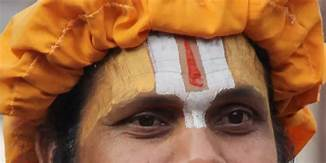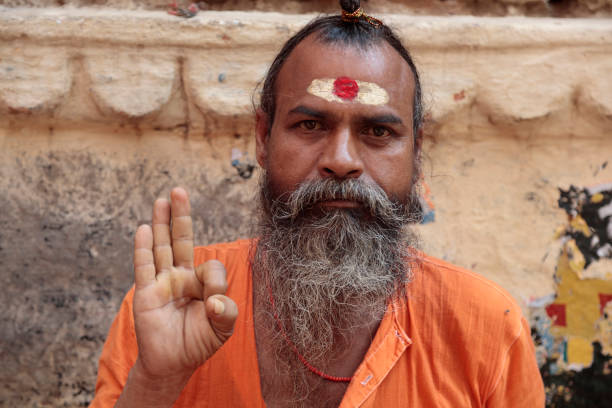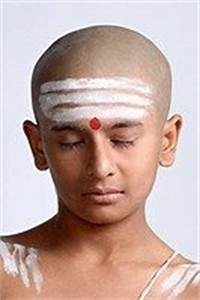[GHHF] "World Bindi Day" Celebration: Apply Traditional Kumkum/ Tilak/ Bindi on the Forehead; Bindi Stickers are Hazardous to Health
 Let us all congratulate the organizers of “World Bindi Day” for their foresight in proclaiming the importance of applying Kumkum/Tilak/Bindi. Let our scriptures speak as we reemphasize the significance of Tilak/Bindi.
Let us all congratulate the organizers of “World Bindi Day” for their foresight in proclaiming the importance of applying Kumkum/Tilak/Bindi. Let our scriptures speak as we reemphasize the significance of Tilak/Bindi.
Kumkum/Bindi / Tilak is applied in the center of the forehead or on the sixth chakra which is located in between the two eyebrows. This spot is considered Ajneya Chakra which is deemed as the Commanding center. It is believed to be the converging point of major nerves. It is the junction where the highest number of neurons meet, hence described as the most important yet sensitive area. There is spiritual and scientific significance to the concept of Kumkum/Bindu /Tilak. This Center controls the entire body. This is the only Chakra exposed to outside while the rest of the chakras are covered with either clothes or hair. This is the chakra that makes all the decisions. It is immensely important to protect from outside forces or evil eyes. This is the point that controls the entire body. Maharishi Yagnavalkya said that this position is appropriate because Shiva's third eye is located here. After the application of Tilak pure thoughts are said to emerge. In fact, our scriptures say that a forehead without a Tilak is as good as a village without a well, a country without a river, a country without justice, wealth that is not given away as charity, a flower without smell, etc.
Depending on one’s inclination, one may apply Tilak, sandal paste, or ash on the center between the eyebrows. Application of Tilak, Sandal Paste, or Ash will have a cooling effect, medicinal value, and spiritual influence. Saivas apply three horizontal lines with the sacred ashes (Tripundra). The Vaishnavas apply three vertical lines (Urdhva Pundra) on the forehead. Fingers are used for applying the Tilak. While applying Tilak, people chant this mantra: :My I remember the Lord. May this pious feeling pervade all my activities. May I be righteous in my deeds.”
Brahma Vaivarta Purana, Skanda Purana, Brahmanda Purana, Padma Purana, and other Puranas talk about the significance of Tilak on the forehead. During religious ceremonies, the efforts bear no fruits if Tilak is not applied on the forehead. No priest will either enter the Garbha Griha or perform any pujas/homas without sporting Kumkum/Bhasma/Chandan. Kalagni Rudra Upanishad, a Shaiva traditional text, explains the three lines of a Tilak as a reminder of various triads: three sacred fires, three syllables in Om, three gunas, three worlds, three types of atman (self), three powers in oneself, and first three Vedas.
The Vasudeva Upanishad, a Vaishnava tradition text, similarly explains the significance of three vertical lines in Urdhva Pundra. Three vertical lines represent of Brahma, Vishnu, Shiva; the Vedic scriptures – Rigveda, Yajurveda and Samaveda; three worlds Bhu, Bhuva, Svar; the three syllables of Om – A, U, M; three states of consciousness – awake, dream sleep, deep sleep; three realities – Maya, Brahman, and Atman; the three bodies – Sthula, Sukshma, and Karana.(Wikipedia)
According to the Brahmanda Purana, the colors and manner of application of the tilak are important: "a red Tilak will bring obedience and control; a black Tilak will derive peace; a yellow one will bring wealth; one which is white will deliver devotion to Vishnu. The Tilak of correct size, marked using one’s fingers, will offer the god’s blessing and support. A Tilak in the centre of the forehead will bring youth and long life; the Chandan made using the third finger (Anamika) will deliver happiness; and a bounded Tilak will eventually bring salvation".
 Kumkum is most often applied on the forehead with a ring finger as one presses on the center of the eyebrows. Both women and men should apply Tilak as per our scriptures. Our ancient Rishis used to press that center when applying Tilak to activate the pituitary gland in order to meditate better. The pituitary gland is a small organ, at the bottom of the brain. It is the master gland of the human body, this gland produces and secretes many hormones that travel throughout the body, directing certain processes stimulating other glands to produce different types of hormones. The pituitary gland controls biochemical processes important to our well-being.
Kumkum is most often applied on the forehead with a ring finger as one presses on the center of the eyebrows. Both women and men should apply Tilak as per our scriptures. Our ancient Rishis used to press that center when applying Tilak to activate the pituitary gland in order to meditate better. The pituitary gland is a small organ, at the bottom of the brain. It is the master gland of the human body, this gland produces and secretes many hormones that travel throughout the body, directing certain processes stimulating other glands to produce different types of hormones. The pituitary gland controls biochemical processes important to our well-being.
The application also activates the pineal gland which may have the highest concentration of energy in the body. The pineal gland is also the dominant source of the body’s melatonin, which affects our mood, immune function, circadian rhythms, and sleeping patterns. When melatonin levels are disrupted, people can experience mood swings, depression, and seasonal disorders. The pineal gland also plays an important role in the production of serotonin which regulates moods, sleeping patterns, promotes digestion, and inhibits impulsive behavior.
Benefits of Traditional Bindi Application
Traditional Kumkum is made with Turmeric and Slake lime. Turmeric has anti-inflammatory and antioxidant properties. Traditional kumkum has many medical and spiritual benefits. It makes one calmer and helps arrest anxiety. Some of the benefits of applying Tilak on the forehead are relieves headache, clears up sinuses, strengthens your facial muscles and can beat wrinkles, relieves the symptom of Bell’s palsy, good for the muscles of the eyes, stimulates hearing, beats insomnia, and others.
Chandan Application
 Applying Chandan paste on Ajneya Chakra improves focus and alertness. It has a cooling effect on the nervous system. It is believed to ease headaches and cool the nerve centers that are exposed to sun. Negative energy in the form of negative thoughts enter our body through this chakra. Application of Chandan is believed to block the negative energy. Many people suffer from insomnia due to excessive thinking, overactive mind, mental stress, and exhaustion. Massaging while applying Chandan paste is believed to reduce stress and insomnia.
Applying Chandan paste on Ajneya Chakra improves focus and alertness. It has a cooling effect on the nervous system. It is believed to ease headaches and cool the nerve centers that are exposed to sun. Negative energy in the form of negative thoughts enter our body through this chakra. Application of Chandan is believed to block the negative energy. Many people suffer from insomnia due to excessive thinking, overactive mind, mental stress, and exhaustion. Massaging while applying Chandan paste is believed to reduce stress and insomnia.
In fact, many Chandan paste is applied to Gods and Goddesses who have displayed ferociousness in the scriptures. Lord Narasimha displayed so much anger at the time of killing Hiranyakashapu, his devotees applied Chandan to cool him down and the practice is still followed till date in Sri Simhachalam Temple and Mangalagiri Narasimha Temple and other Lord Narasimha Temple all across India.
 Ash Application
Ash Application
Ash/Bhasma/ Vibhuti is applied on the forehead . The benefits of wearing Vibhuti on the forehead are that it increases positive energy, prevents headaches, prevents colds, clears the sinuses, regulates all seven chakras in the body and develops compassion toward others. Spiritually, it reminds us of the impermanence of our lives.
Bindi Stickers are Health Hazard
Bindi Stickers: For convenience and ease of application, many people are applying Bindi stickers on their foreheads. These stickers are made out of glue and metals which may affect the very commanding center that we need to protect from chemicals and metals. These stickers are considered to have a negative effect on one’s health and spirituality. In a survey conducted by the Consumer Unity and Trusts Society (CUTS), Kolkata, in November 2001, half of the respondents (consumers) said that they had suffered allergic reactions to personal care products. Gyanshankar Mishra, Sushil Rathi and Jasmin Mulani concluded that, “The synthetic adhesive used in sticker bindis may lead to eczema, leukoderma or skin irritation. The use of sticker bindis can cause white patches on the forehead. Another study also concludes that “The dermatological effects that have been linked with Bindi use include contact leukoderma, allergic contact dermatitis and granuloma formation [6]. Our patient used sticker Bindi. Long-term use of these bindis may be associated with local skin breach due to repeated and regular skin contact of adhesives on the Bindi. These could be the possible causes of exogenous inoculation of the infection in the present case.” (2015)
V A Babu and K Sri Venkatesan (2016) summarized the research on the effects of Sticker Bindi as follows:
“Sticker Bindi is a synthetic fabric or plastic patch made up of circular discs of polyvinyl chloride (PVC) and the adhesive material contains P-tertiary butyl phenol (PTBP) Other agents are epoxy resins, dispersible blue , dispersible blue, nickel thimerosal and gallate mix.12 Nickel in sticker Bindi can cause allergic contact dermatitis. Sticker Bindi can also cause contact leukoderma due to PTBP used as adhesive which is melanotoxic.”
Let all Hindu participate in the World Hindu Day and revive the tradition of applying Kumkum/Tilak/Chandan/Ash on their foreheads with pride, understands the scriptural injunctions, herald the inner meaning of sporting Kumkum to the world, and let all faiths know the importance and significance of wearing Kumkum/Tilak on their foreheads. Both women and men should wear the Tilak/Bindu on their foreheads. Know the importance of wearing Tilak, become a spokesperson.











 Urgent support needed for Bangladesh Hindus
Urgent support needed for Bangladesh Hindus 







